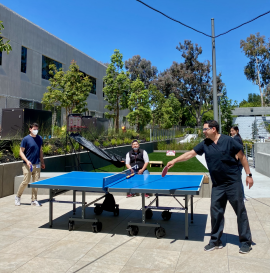The Hub Opens at Stanford Research Park
May 10 2022
Posted In:
20/20 Blog
Palo Alto, CA — Translational research is not just a buzz phrase at Stanford University. It is a serious aim that drives Stanford scientists, physicians, and administrators. The department of ophthalmology’s translational research laboratories are housed among the industrial buildings that comprise Stanford Research Park.

Established on Page Mill Road in 1951 by Stanford University and the City of Palo Alto, the 700-acre research park brings together the best scientific minds and the most innovative entrepreneurs to accelerate the process of turning laboratory breakthroughs into life changing products.
It is here that Stanford plans to continue to build a talented community of scientists, bioengineers, and entrepreneurs who will transform medicine with innovations in precision medicine, medical devices, and digital health.
The grand opening of The Hub at 3215 Porter Drive, housing Coupa Café, Mike’s Bikes, The Stanford Room, and SRP GO, the park’s commuter services, signals the continued growth and success of the park, home to over 30,000 employees that work for Stanford University as well as tech giants like Tesla, HP, and VMware.
Vinit Mahajan M.D., Ph.D., associate professor and vice chair of ophthalmology research, and several of his lab team members attended the grand opening.
Mahajan said, “We walked over from our lab at 1651 Page Mill Road and were really impressed by the modern, open space. It was great to run into colleagues from other departments in such a relaxed, inviting atmosphere. There is no better way to share ideas and get creative during the day than by playing ping pong, taking a few basketball shots, or sharing an afternoon cup of coffee.”
Mike’s Bikes sells, rents, and repairs bikes, and Coupa Café provides gourmet coffee, breakfast, and lunch Monday through Friday from 7:30 AM to 3 PM to approximately 8,000 employees working at companies in close proximately, including Stanford scientists in the Life Science District of the park.
“The Hub makes the Life Science District feel like it is part of the Stanford campus, which is less than two miles away,” lab member Jennifer Vu said.
In addition to ophthalmology labs, the new Life Science District includes labs from the departments of cardiology, medicine, and psychology.
The Alexandria Center for Life Science at Stanford Research Park at 3160 Porter Drive is the central location for Stanford faculty to commercialize their discoveries. The incubator provides resources that help scientist-entrepreneurs through growth stages including move-in-ready labs, strategic programming, and access to seed money.
“Since joining Stanford,” Mahajan said, “my lab has had incredible opportunities to collaborate with colleagues across campus but also with start-ups across Silicon Valley. Stanford’s vision and investment will keep driving technological growth.”
A conference center at 3145 Porter Drive accommodating 200 people and a large conference room at 1651 Page Mill Road accommodating 100 people, have been the main meeting spaces where people come together for lectures and conferences. The Stanford Room at The Hub is also designed for this purpose. Lunch & Learns will be held in the room during noontime and will feature a variety of topics on wellness, creativity, and finance. In the evenings, the room will be used for a speaker series that brings together Stanford leaders and business leaders in the community.



